

Asteroid 2000 WO17 on November 14, 2020, headed for closest approach to Earth on November 29. Image via JPL Small Body Database.
A large asteroid – labeled (153201) 2000 WO107 – will sweep past Earth in late November, providing astronomers with a good opportunity to study it. Closest approach to Earth will happen on November 29, 2020 at 05:08 UTC; translate UTC to your time. The asteroid is an estimated 1,640 feet (500 meters, which is half a kilometer or 1/3 mile). It will pass at 11.19 times the Earth-moon distance, a very safe distance.
The asteroid will not be visible to the eye, but people with small telescopes might catch it; see the charts below. Astronomers are gearing up to observe this asteroid further, in part because of its relatively large size, and in part because subsequent passes of 2000 WO107 will be closer than this year’s pass.
Asteroids come in all sizes. How big is 2000 WO107 in contrast to other asteroids known to pass Earth? In recent years, astronomers have begun catching sight of smaller and smaller asteroids as they sweep past us. Compare 2000 WO107 at 500 meters (about 0.5 km or 1/3 mile) to asteroid 2020 SW, which came within 7% of the moon’s distance on September 24, 2020. SW was estimated to be only about 4.5 to 10 meters in diameter (roughly 15 to 30 feet). Now compared 2000 WO107’s 500 meters with the largest object in the asteroid belt between Mars and Jupiter. That object is Ceres, and it’s some 473,000 meters (473 km or 170 miles) in diameter.
Asteroids travel at different speeds. Large asteroid 2000 WO107 is a fast-moving space rock, traveling through space at the amazing speed of 56,080 miles per hour (90,252 km/h) or 25.07 km per second. By contrast, 2020 SW swept past Earth at only 17,336 miles per hour (27,900 km/h).
Astronomers will study 2000 WO107 by bouncing radar signals from its surface and afterwards by analyzing the signals that are reflected. These observations are planned at the Goldstone Deep Space Communications Complex in California, scheduled for November 27 to December 1, 2020.
Radar observations of asteroids result in images that show us the asteroid’s shape. It’s always lots of fun to see the shapes of these great boulders or mountains hurtling through space. According to NASA/JPL, the observations of 2000 WO107 might allow scientists to determine the space rock’s composition. The asteroid might be metallic, or it might be an optically dark rock, that is, a rock that is dark in the visible light part of the electromagnetic spectrum.

Animation of radar images of asteroid 2015 HM10 as it passed by Earth on July 7, 2015. The asteroid, which ranges in size from 40 to 80 meters, was approximately 440,000 kilometers from Earth at the time of the observations. Image via NASA/ JPL-Caltech/ NRAO/ AUI/ NSF.
Astronomers at the Lincoln Near-Earth Asteroid Research project (Project LINEAR) in New Mexico discovered 2000 WO107 on November 29, 2000. NASA’s NEOWISE space telescope has also been used to observe it; NEOWISE determined that the asteroid’s size is about 510 meters in diameter.
Asteroid 2000 WO107 is classified as an Aten type, that is, an Earth-crossing space rock with an orbit not dissimilar from Earth’s. The asteroid completes an orbit around the sun once every 318 days. Its path brings it between the orbits of Mercury – our sun’s innermost planet – and Earth. Orbit models indicate that, in addition to coming close to Earth on occasion, this asteroid also makes close approaches to Mars, Venus and Mercury.
After the November 29, 2020, visit to Earth, the asteroid will return, passing slightly closer on each subsequent flyby – first in November 2040 – and then in November 2093. An even-closer flyby will happen on December 1, 2140, when the asteroid will pass at about half the Earth-moon distance. Because of its size and occasional relatively close flybys, asteroid 2000 WO107 has been classified as a Potentially Hazardous Asteroid. However, no risk of impact has been detected, as its orbit is well known.
Will asteroid 2000 WO107 be visible when it sweeps past Earth in late November? Not to the eye alone. During this November’s flyby, asteroid 2000 WO107 should reach a visual magnitude of 12 to 13.5. That means observers using a 6-inch or 8-inch telescopes, or larger, might be able to see the space rock, which will look from Earth like a slowly moving star.
Although closest approach to Earth occurs during a full moon, observers pointing a computerized telescope at the correct position and time might still be able to spot the asteroid moving in front of the stars.

Location of asteroid 2000 WO107 on the night of November 29, 2020 at 10:00 CDT, as seen from U.S., facing east. Illustration by Eddie Irizarry using Stellarium.

Observers using a GoTo or computerized telescope can point their instruments to one of these reference stars, to try to locate the asteroid, which will appear as a slow moving “star.” Carefully observe the stars’ pattern through the telescope, and compare the view 5 to 10 minutes later to detect an apparent star that changed position (the space rock). Illustration shows the location at 10:00 p.m. CDT on November 29, 2020. Illustration by Eddie Irizarry using Stellarium.
Bottom line: Asteroid 2000 WO107 is an estimated 1,640 feet (500 meters, or half a kilometer) in diameter. It will pass at 11.19 times the Earth-moon distance, a safe distance, on November 29, 2020. Charts here for telescope users.
from EarthSky https://ift.tt/3jEceMn


Asteroid 2000 WO17 on November 14, 2020, headed for closest approach to Earth on November 29. Image via JPL Small Body Database.
A large asteroid – labeled (153201) 2000 WO107 – will sweep past Earth in late November, providing astronomers with a good opportunity to study it. Closest approach to Earth will happen on November 29, 2020 at 05:08 UTC; translate UTC to your time. The asteroid is an estimated 1,640 feet (500 meters, which is half a kilometer or 1/3 mile). It will pass at 11.19 times the Earth-moon distance, a very safe distance.
The asteroid will not be visible to the eye, but people with small telescopes might catch it; see the charts below. Astronomers are gearing up to observe this asteroid further, in part because of its relatively large size, and in part because subsequent passes of 2000 WO107 will be closer than this year’s pass.
Asteroids come in all sizes. How big is 2000 WO107 in contrast to other asteroids known to pass Earth? In recent years, astronomers have begun catching sight of smaller and smaller asteroids as they sweep past us. Compare 2000 WO107 at 500 meters (about 0.5 km or 1/3 mile) to asteroid 2020 SW, which came within 7% of the moon’s distance on September 24, 2020. SW was estimated to be only about 4.5 to 10 meters in diameter (roughly 15 to 30 feet). Now compared 2000 WO107’s 500 meters with the largest object in the asteroid belt between Mars and Jupiter. That object is Ceres, and it’s some 473,000 meters (473 km or 170 miles) in diameter.
Asteroids travel at different speeds. Large asteroid 2000 WO107 is a fast-moving space rock, traveling through space at the amazing speed of 56,080 miles per hour (90,252 km/h) or 25.07 km per second. By contrast, 2020 SW swept past Earth at only 17,336 miles per hour (27,900 km/h).
Astronomers will study 2000 WO107 by bouncing radar signals from its surface and afterwards by analyzing the signals that are reflected. These observations are planned at the Goldstone Deep Space Communications Complex in California, scheduled for November 27 to December 1, 2020.
Radar observations of asteroids result in images that show us the asteroid’s shape. It’s always lots of fun to see the shapes of these great boulders or mountains hurtling through space. According to NASA/JPL, the observations of 2000 WO107 might allow scientists to determine the space rock’s composition. The asteroid might be metallic, or it might be an optically dark rock, that is, a rock that is dark in the visible light part of the electromagnetic spectrum.

Animation of radar images of asteroid 2015 HM10 as it passed by Earth on July 7, 2015. The asteroid, which ranges in size from 40 to 80 meters, was approximately 440,000 kilometers from Earth at the time of the observations. Image via NASA/ JPL-Caltech/ NRAO/ AUI/ NSF.
Astronomers at the Lincoln Near-Earth Asteroid Research project (Project LINEAR) in New Mexico discovered 2000 WO107 on November 29, 2000. NASA’s NEOWISE space telescope has also been used to observe it; NEOWISE determined that the asteroid’s size is about 510 meters in diameter.
Asteroid 2000 WO107 is classified as an Aten type, that is, an Earth-crossing space rock with an orbit not dissimilar from Earth’s. The asteroid completes an orbit around the sun once every 318 days. Its path brings it between the orbits of Mercury – our sun’s innermost planet – and Earth. Orbit models indicate that, in addition to coming close to Earth on occasion, this asteroid also makes close approaches to Mars, Venus and Mercury.
After the November 29, 2020, visit to Earth, the asteroid will return, passing slightly closer on each subsequent flyby – first in November 2040 – and then in November 2093. An even-closer flyby will happen on December 1, 2140, when the asteroid will pass at about half the Earth-moon distance. Because of its size and occasional relatively close flybys, asteroid 2000 WO107 has been classified as a Potentially Hazardous Asteroid. However, no risk of impact has been detected, as its orbit is well known.
Will asteroid 2000 WO107 be visible when it sweeps past Earth in late November? Not to the eye alone. During this November’s flyby, asteroid 2000 WO107 should reach a visual magnitude of 12 to 13.5. That means observers using a 6-inch or 8-inch telescopes, or larger, might be able to see the space rock, which will look from Earth like a slowly moving star.
Although closest approach to Earth occurs during a full moon, observers pointing a computerized telescope at the correct position and time might still be able to spot the asteroid moving in front of the stars.

Location of asteroid 2000 WO107 on the night of November 29, 2020 at 10:00 CDT, as seen from U.S., facing east. Illustration by Eddie Irizarry using Stellarium.

Observers using a GoTo or computerized telescope can point their instruments to one of these reference stars, to try to locate the asteroid, which will appear as a slow moving “star.” Carefully observe the stars’ pattern through the telescope, and compare the view 5 to 10 minutes later to detect an apparent star that changed position (the space rock). Illustration shows the location at 10:00 p.m. CDT on November 29, 2020. Illustration by Eddie Irizarry using Stellarium.
Bottom line: Asteroid 2000 WO107 is an estimated 1,640 feet (500 meters, or half a kilometer) in diameter. It will pass at 11.19 times the Earth-moon distance, a safe distance, on November 29, 2020. Charts here for telescope users.
from EarthSky https://ift.tt/3jEceMn

Aucun commentaire:
Enregistrer un commentaire